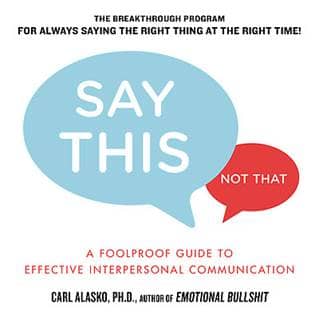
Do your words often create the opposite effect of what you were hoping for – escalating tensions rather than solving problems? Author Carl Alasko believes that anyone can learn effective communications skills. In Say This, Not That, he provides simple instructions for what to say – and what not to say – in the moments when it really counts (and not after the fact, when it doesn’t). Accompanying each set of statements is a brief discussion about what makes one statement negative and destructive, and the other positive and effective.
Guiding you in cultivating the ability to say what you really want to say in all areas of life – from dating and relationships to parenting and the workplace – Say This, Not That is the ultimate resource for anyone who longs to consistently say the right thing at the right time.
SCENE 18: Why Are You So Grouchy?
THE SITUATION: Your girlfriend comes home in a sullen, grouchy mood. Within seconds you’re feeling upset at her for ruining your evening.
DON’T SAY THIS (accusingly): “Geez, what’s wrong with you?” (Sending the wrong message: I can’t deal with any uncomfortable feelings.)
REMEMBER YOUR RESPONSIBILITY: Your job is to be supportive of your partner’s feelings, even if the emotion may seem exaggerated, silly, useless, etc. To imply otherwise will make your partner feel as though she can’t trust you to deal with uncomfortable situations.
DON’T LET OTHERS’ FEELINGS OVERWHELM YOU: When we care about another person, we also care about their feelings . . . and their struggles. But jumping into their emotional swimming pool is never a good idea: Now you’re both wet! If you have healthy emotional boundaries, you won’t allow yourself to be taken over by another’s feelings. You need to maintain your own emotional independence so that you can express empathy, but not resentment. Without empathy, there can be no authentic closeness.
SAY THIS: “I’m sorry you’re feeling down. Is there something you’d like to talk about?” (Sending the right message: I’m strong enough to handle your feelings.)
PRACTICE CLOSENESS, NOT DISTANCE: There’s no such thing as a correct or incorrect feeling (except for rage—excessive anger expressed through screaming or violence—for which there’s no justification). When caught up in any emotion, we all need someone to hear us and acknowledge our feelings. We especially want the people closest to us to understand what we’re going through, or least make an effort. The more sincere the effort, the more people will feel loved.
LOVE IS A VERB: To love means to put forth a sincere effort to understand the other person’s reality. You don’t have to act like a therapist and say something to “cure” the situation. All you need to do is be present and available to listen.
THE MIRACLE OF LISTENING: Countless stories attest to the healing power of a good listener. It doesn’t take skill; it simply requires a willingness to be present. This willingness is instantly understood as love. However, if listening attentively doesn’t come easily to you, keep in mind that it is a skill that you can learn how to be a better listener . . . and it gets easier with the first sign of success.
Excerpted from Say This, Not That: A Foolproof Guide to Effective Interpersonal Communication by Carl Alasko, Ph.D. Copyright © 2013 by Carl Alasko, Ph.D. Published by Jeremy P. Tarcher, an imprint of Penguin, a division of Penguin Group USA, a Penguin Random House Company.

